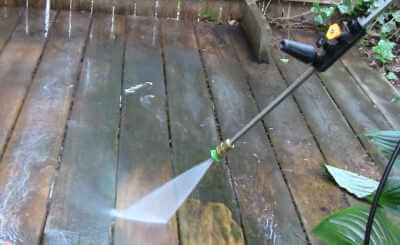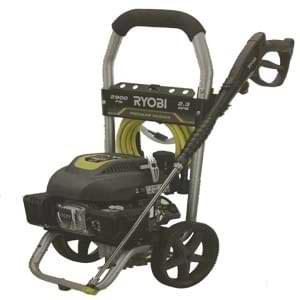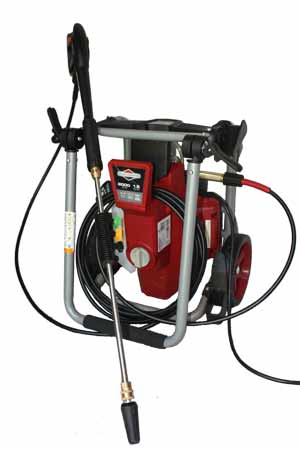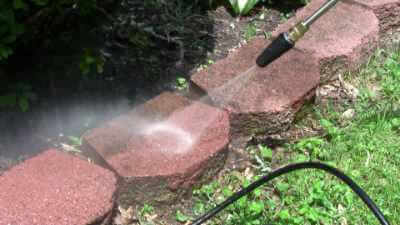Choosing and Using a Pressure Washer
by: Dale Cox

If you have outdoor projects around your house that include cleaning, you probably have surfaces like wood, concrete, brick, vinyl siding and more covered with dirt, algae, and road grime. It can be hard to find the time and energy to tackle all these jobs when so many areas need attention. Fortunately, there's a way to take care of most outdoor cleaning projects like this without devoting tons of time and effort to the cause. An inexpensive, compact, easy to use pressure washer can make cleaning things up around the house quick, easy, and even fun.
A pressure washer uses water from your garden hose which typically supplies about 50psi, and pumps it up by 20, 40 or even 60 times, allowing you to force dirt, algae, grease, grime, etc. from all kinds of surfaces around the house and shop with the squeeze of a trigger.
From cleaning your deck, house siding and masonry surfaces, to removing graffiti, degreasing just about anything, and even clearing leaves and sticks from gutters, a pressure washer can cut the time and labor required for these jobs to a fraction of manual efforts.
Types of Pressure Washers


There are basically two kinds of pressure washers for home use on the market today, gas powered models which have been around since the 80's, and a more recent arrival on the scene, electric pressure washers. The water pressure produced by these machines ranges from around 1800psi for electric models, up to 3000psi or more for gas powered washers.
You can buy or rent a pressure washer but owning one is probably best if you have a lot of cleaning projects to do or even just one or two that will have to be done annually. Having a washer on hand when you need it will allow you to do each job as it comes up without having to fit them all into one rental period.
The price range for consumer electric pressure washers start at about $150 and go up from there. Gas powered machines start at around $300 and can go as high as $1,000 or more. Unless you have a cleaning project where there's no electrical outlet or you need to clean 2nd story gutters and siding, a gas powered pressure washer is really not necessary. And since electric models are much easier to use and maintain, they can be a very attractive choice for most homeowners.
Pressure Washer or Power Washer?
While most consumer pressure washer models use cold water, hot water machines are also available. A pressure washer with hot water capability is known as a power washer. It is this one feature, the ability to heat water to supply the machine, that makes the difference between a pressure washer and a power washer.
Because a power washer will cost about 10 times more than a typical pressure washer, it's fortunate that power washers are really overkill for household cleaning projects. Short of such jobs as removing graffiti spray paint from concrete or cleaning greasy industrial equipment, a power washer is simply not necessary.
Choosing a Pressure Washer
Pressure washers are rated using a measurement known as cleaning units with a higher number reflecting more efficient cleaning. The cleaning units number is a product of the psi rating of the machine multiplied by the water flow rate in gallons per minute, gpm. While the water pressure is what enables separating contaminants from a surface, it's the flow rate that determines how long it takes to do the job. Flow rates vary by machine from about 1.5gpm up to around 4gpm. A machine with a low pressure rating and high flow rate can therefore out perform a machine with higher pressure and an average flow rate. However, a higher flow rate will also mean you use more water which lowers the resource efficiency of the machine.
Because electric pressure washers don't provide more than about 1800psi, they lack the power needed for some household projects like cleaning 2nd story gutters. Also, projects not located within about 60 feet of an electric outlet will be impossible to do with an electric washer.
Gas powered pressure washers have some limitations too. Your project still needs to be near a water source providing the minimum pressure and water flow rate required by the washer. Also, gas washers run constantly and are very loud. The maintenance of a small gasoline engine is also more involved and they are susceptible to mechanical failure if not kept in tiptop mechanical condition. By contrast electric washers require very little maintenance and they run much quieter. In addition with electric washers, the pump motor will turn off and on as you engage the trigger, saving energy and wear on the system.
Pressure Washer Nozzles
A nozzle is attached to the end of the washer spray wand to focus water onto a surface. There are typically 5 different nozzles, often called spray tips included with a pressure washer. By varying the spray tip, you can vary the pattern and as a result, the relative force of the water hitting a surface.
Not all pressure washers will come with all 5 standard tips but most will. The tips are color coded to make it easier to select the one you need on the fly without having to examine it too closely. The color scheme uses red for a 0º spray pattern, yellow for 15º, green for 25º, white for 40º, and black for a wide angle soaping tip.
Pressure washer tips are universal and attach to the wand with a quick release coupler but tips from some sources may fit poorly or leak because of inferior manufacturing. If you have to buy replacements for lost tips or you want to use a specialty tip, be sure to buy from a reputable source and don't choose tips based on low price alone.

Specialty Spray Nozzles
In addition to the standard 5 sizes, there are also specialty tips available to enhance washer capability. A turbo nozzle, like the one pictured here, is included with most pressure washers. This specialty tip provides more force and applies it in a randomly oscillating circular pattern which can make removing stains faster and more effective.
Another special attachment that can really expand your pressure washer's use is a wand extension with a hook on the end for cleaning gutters. Using this extension in combination with a turbo tip, you can dislodge and blow out leaves, sticks, and other debris from single story rain gutters all while standing on the ground.
Depending on the pressure washer model, you may also be able to add a scrubber head to your spray wand. These specialty attachments use the water pressure from the machine to rotate a scrub brush allowing you to thoroughly clean surfaces without a lot of physical effort on your part. This can make cleaning house siding in particular much easier and effective.
For cleaning driveways and decks, a surface cleaner attachment is available. This is a round disk with rotating spray tips mounted underneath and a quick connector for attaching to your spray wand. The spray tips spin under the deck of the attachment as you move it over a horizontal surface increasing coverage and making cleaning large areas faster and easier.
Sizes range from about a 10 inch diameter up to 24 inches or so. Prices start at around $30 and can go up to a couple hundred or more. These attachments have a psi rating so you have to match them to the pressure your machine can supply and they will usually be recommended for either an electric or gas powered pressure washer.
Using a Pressure Washer
The mist from a pressure washer will be hard to avoid, especially when working on vertical surfaces. At the very least you should wear rubber boots when washing decks and driveways and a raincoat or poncho if you have to spray overhead. Always wear safety goggles to avoid eye injuries from debris that can be thrown off by high water pressure. Keep a strong grip on the spray wand as you engage the trigger to prevent the sudden force from knocking you off balance. As you work, be aware of the surroundings and keep hoses, cords, etc. out of your path.
Extra care should be taken when using an electric pressure washer due to the need to feed electricity to the motor. Water and electricity are an extremely dangerous combination, so be sure all safety features of the machine are in good working order and only plug it into a tested GFCI electrical outlet.
Whenever you choose to use a pressure washer, first consider if the surface can withstand the force your particular machine puts out. Some gas powered washers will allow for adjusting the pressure by moving a dial but most machines don't have this option. Typically, pressure is adjusted by switching between the various spray tips mentioned above. Also, moving the spray tip farther from the surface will lower the pressure applied, however, cleaning effectiveness will diminish as well the farther away you get.
As a general rule, use the lowest pressure tip that will work and move up as needed. Looking at the chart above, the red tip will apply the most pressure and concentrate it to a small, dime-sized area. This can be effective for removing stains from concrete or other very hard surfaces but will rip a hole in softer materials. The yellow tip will apply a 15º spray pattern at slightly less pressure than the red, 0º tip. Each subsequent tip will expand the spray area and reduce the pressure of the water.
Spray Wisely
There are many surfaces around the house where using a pressure washer makes good sense to do a thorough cleaning and help maintain outdoor structures. There are also some areas where spraying water at extremely high pressure can damage a surface or create other problems. On house siding, for example, extreme pressure can easily force water behind the exterior wall covering and into the interior where it can soak insulation, damage drywall, and cause mold to develop inside dark cavities. On decks, high pressure can literally rip the wood fibers off and wash them away leaving your deck severely damaged and looking decades old. Also, windows and solar panels can be easily broken when trying to clean the glass using too much water pressure.
Before beginning to clean with a pressure washer, test spray in an inconspicuous spot to be sure the surface you're working with won't be damaged. While cleaning, spray at an angle keeping the tip a foot or more above the surface. Use care to keep the wand moving as you spray to avoid cutting into the surface in one spot. Watch where you direct the wand and avoid spraying water into vents, light fixtures, and other opening that may cause damage.
Using Detergent
Many consumer model pressure washer have an onboard tank for detergent that can be applied to surfaces before spraying to improve cleaning results. Other models use a siphoning attachment inserted into a bucket of detergent to apply soap. Typically the black, low-pressure nozzle is used when soaping is desired. In some cases you have to flip a valve to dispense soap from the tank. With other models simply filling the soap tank and using the soaping nozzle will initiate flow and switching to the higher pressure tip will pause soaping.
To apply soap, fill the detergent tank or setup the siphon attachment. Be sure to only use a detergent intended for use with a pressure washer. Be aware that in some cases, the manufacturer may require only their brand of detergent be used, so check first. Never use bleach in a pressure washer. Most other chemicals are also prohibited, so check your manual before adding anything but a detergent made for pressure washers.
Attach the black, low-pressure tip to the spray wand. Most machines will only siphon soap with a low-pressure nozzle installed. Apply the soapy spray starting at the bottom and work your way up on vertical surfaces to prevent streaks. Cover the entire area to be cleaned and keep it wet until you're ready to rinse. Apply soap repeatedly if need be to keep everything saturated. Try to wash when the sky is overcast if possible to prevent the sun from drying things out too quickly. When you're ready to rinse, clear all soapy water from the hose using a high pressure nozzle. Then rinse the soap off the surface starting at the top and working your way down.